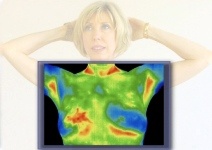If you’ve always followed the religion of annual mammograms and if you’re confused by recent government guidelines recommending fewer mammograms over a woman’s lifetime, you’ve come to the right place.
guidelines recommending fewer mammograms over a woman’s lifetime, you’ve come to the right place.
Thermograms are a safe and effective alternative to mammograms. I’ve been getting thermograms annually for years.
Here’s some information on thermograms from The Secret of Health: Breast Wisdom, a book I wrote with Dr. Ben Johnson:
Thermography is absolutely the best preventive tool because it can pick up a potential problem long before a mammogram might, yet, unlike a mammogram, it is noninvasive, painless and exposes you to no radiation.
Thermography has been FDA-approved for more than 30 years and can be used for all types of body tissue, not breasts alone. A thermogram offers information about your breasts that no other technology can provide. It’s best use is as a preventive tool to track a woman’s breast health over a period of years and to catch potential problems before they become big problems.
Thermography is an infrared heat digital imaging system. The machine does not even touch your skin. It shows color images of heat in the tissue and gray scale, which shows vascularity or circulation in the breast.
How thermography works
A thermogram is made by a specialized type of digital camera that captures an image of the formation of blood vessels and the circulation of blood in your tissues. Having a thermogram is as easy as having your picture taken.
Normal tissue has a blood supply that is under the control of the autonomic nervous system (ANS). The ANS can either increase or decrease blood flow to cells. Abnormal (cancerous and pre-cancerous) tissue, on the other hand, ensures its own survival by secreting chemicals that override this ANS regulation, thereby ensuring its own steady blood supply. Cancer can be thought of as being “off the power grid” of the body.
A thermogram monitors changes in circulation that can signal the presence of a tumor.
Thermogram benefits
Breast thermography does not diagnose breast cancer. Instead, it detects changes in breast tissue that indicate the presence of cancer or pre-cancerous states, long before a mammogram might detect abnormal masses.
Breast thermography has several unique abilities that make it well worth your while:
- It can give tumor warning signals far in advance, up to ten years ahead of invasive tumor growth.
- Unlike an after-the-fact warning when a tumor is already present like you’d get with a mammogram, ultrasound, MRI or CT scan. Thermography can assess a woman’s risk of developing a tumor and can also assess her hormonal status.
- It can also distinguish between fibrocystic breasts and cancerous tumors.
- It can examine breasts with implants, which cannot be adequately screened with routine mammography because the compression could damage the implant and because the implant can actually block the view of deeper parts of the breast.
- It is effective for breasts of all sizes. Women with very small, very large breasts or very dense often do not receive adequate images from mammograms.
- The rate of false negatives and false positives is less than 10 percent, much better than for mammograms.
What an abnormal thermogram means
Women with a family history of breast cancer are at greater risk of developing the disease, but 75% of women who get breast cancer have no family history of the disease. Regardless of your family history, if your thermogram is abnormal, you run a future risk of breast cancer that is 10 times higher than someone with a first degree relative (mother, sister or daughter) with the disease.
Thermography is the only technology to provide women with a future risk assessment.
The luxury of time
If a thermogram shows a woman is at risk of developing breast cancer, this can be a warning she needs to work to improve her breast health.
Monitoring with regular check-ups and thermography will show improvements with time or possibly the earliest signs that a problem may exist. This information lets a woman and her doctor know when or if there is a risk of a problem developing and measures like those we discuss in this book can be taken to prevent a tumor from growing and spreading.
Since one of the greatest risk factors for the development of breast cancer is total lifetime exposure to estrogen, normalizing the balance of the hormones in the breast may be the first and most significant step in prevention. Breast thermography is the only known non-invasive procedure that can detect estrogen dominance in the breasts.
Correct hormone imbalances
If a woman’s thermographic images suggest a relative progesterone deficiency (estrogen dominance), treatment of this condition may play an important role in prevention.
With treatment from her doctor, a woman can use this information to balance the hormones in her breasts. Follow-up thermograms are compared to the baseline estrogen dominant images as part of the treatment monitoring process.
All women can benefit from thermography, but those between the ages of 30 and 50 have the best results because their breast tissues are more dense than those of older women and therefore other screening methods can be less exact.








